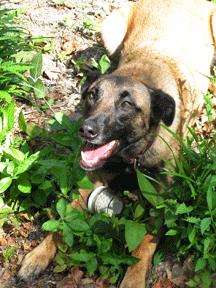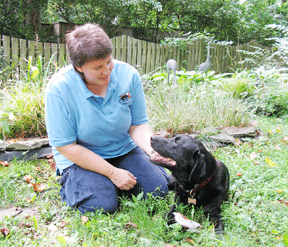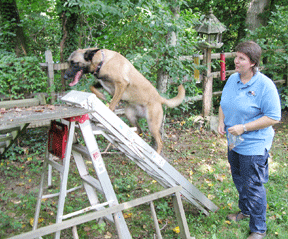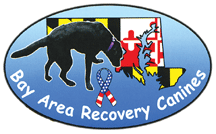
Volume XVII, Issue 34 # August 20 - August 26, 2009 |
 |
The Sniff Sense
There’s nothing like a dog for finding what’s long gone
by Diana Beechener
 |
Having found her container of human ashes, Raven awaits her treat. |
In the flowerbeds that border Heather Roche’s front yard lie human bones, crematorium ashes and a vial of blood. Roche isn’t the Demon Barber of Bay Ridge; she is the founder of Bay Area Recovery Canines — BARC. The remains are training tools to hone the noses of her two cadaver dogs, Red and Raven.
Red, a black Lab and veteran Search and Recovery canine, sweeps the yard first. Snoot to the ground and tail flicking from side to side, Red hits on a scent and lies down, waiting for Roche to confirm a find.
Raven, a Belgian malinois and rookie to the search team, bounds around the yard in an unfocused jumble of long legs and pent-up energy. Settling into search mode, Raven sniffs out the jar of bones. When Roche is slow to acknowledge her find, Raven barks petulantly. Poor form, perhaps, but an excellent find.
Cadaver dogs — called recovery canines by law enforcement — do what human eyes and noses can’t. Trained to detect the scents of decomposition, cadaver dogs can locate hard-to-find human remains, from fragments of bone to a drop of blood to bodies buried 30 feet deep.
Sniffing Out a Career
If you doubt dog detection skills, you’re not alone. Roche started her search career 20 years ago as a canine cynic.
“I actually didn’t think the dogs could do much,” says Roche, a former ground-pounder — that’s a human searcher.
A hiking scare convinced Roche that a dog’s nose knows.
“I was hiking off trail in a wilderness area and got lost,” says Roche. “I had my little six-month-old puppy from the pound, not trained. I had nothing else to do but follow him back down the mountain. I went from being a regular ground-pounder to training my first dog.”
Roche and her dog didn’t start out with deceased searches; she spent 13 years as a wilderness searcher, looking for live-finds.
 |
Heather Roche and her black Lab recovery dog, Red. |
![]() “I was doing wilderness searches, which is looking for anybody from an Alzheimer’s patient to little kids to the hikers who don’t come out,” Roche says. But the job didn’t offer many happy endings. “For over a decade, I only found one alive. Everybody else was deceased. It’s just the nature of incidents.”
“I was doing wilderness searches, which is looking for anybody from an Alzheimer’s patient to little kids to the hikers who don’t come out,” Roche says. But the job didn’t offer many happy endings. “For over a decade, I only found one alive. Everybody else was deceased. It’s just the nature of incidents.”
Dead Men Leave Scents
The evolution of forensic technology and the birth of “the CSI generation” offered Roche and her sniffing searchers a new career path — Search and Recovery. Unlike live-find searches, there is no false hope for a recovery search; dog and trainer are looking for bodies, or what’s left of them.
“So now we weren’t looking for the whole person,” explains Roche. “A lot of times it’s what’s called speculative search — areas to search for whole bodies above ground or if somebody’s buried, the dogs can at least narrow it down.”
Using her dogs, Roche has been able to narrow down searches on land and water, feats that human technology can’t equal.
“University of Tennessee has the Body Farm and is trying to come up with electronic sniffers trying to replicate a dog’s nose,” says Roche. The electronic sniffers can detect decomposition, but they can’t classify it. Searching the woods using electronic sniffers means stopping to identify every dead object, from a fossilized squirrel carcass to deer remains.
Simply put: Dogs can do it better.
Forget running through a stream to mask your scent. Roche’s dogs are used to finding drowning victims, detecting human decomposition while balancing atop the bow of a boat.
The passage of time won’t mask a scent, either. Roche and her dogs work cold cases for the police and have proved their prowess on an archeological dig.
“I’ve had 1,000-year-old confirmed finds with archeologists down in Mississippi,” Roche says. Her dogs toured the site of a Native American burial ground, correctly pinpointing the locations of graves.
Not all Roche’s finds are a cause for celebration, but they often provide a break in a case or closure for families. Roche worked the Pentagon scene after September 11, using dogs to find bits of biological material for DNA identification. When Katrina swept through the Gulf Coast, Roche and her dogs were again called upon to help find remains. The dogs scale eight-foot ladders — a requirement for FEMA-certified searchers — to enter disaster sites, diligently combing the rubble for human signs.

Smell Sensitivity
Finding remains isn’t the hardest part of search and recovery. The pressure for results is. Roche is usually called in when cases go cold or searchers are desperate.
“It’s more of an art than a science with the dogs,” says Roche. “It’s learning to read their body language. You have to train them well, and you just have to trust them.”
Even in the face of horrible tragedy.
“In Pennsylvania, there was a little girl a couple years ago that was missing,” says Roche. “I got called in with the National Center for Missing and Exploited Children on day five. They had found her [four-wheel] ATV buried by the pilings in the woods. They assumed she would be there. We searched the area with the dogs and said nothing’s there.”
Determined to find the girl, the police took Roche and her team to an area that had already been searched — and cleared.
“My dogs laid down. I would have never ever thought that there was anything there,” Roche says. But she trusted Red and Alley, who died a year ago, and told the police to dig. “Well, sure enough, the little girl was down six feet, buried with a backhoe and covered with bags of lye. So here’s a little 12-year-old girl, the parents had been looking for a week practically, and she’s actually just down the road from her house.”
Though her discovery confirmed the worst fears of police and family, Roche is glad she could provide answers. She’s the first to admit that seeking cadavers isn’t the ideal job for everyone.
“I always tell people if they can’t handle dealing with the training aids [bones, blood, ashes], they won’t be able to handle finding the real thing,” Roche says. “So we try to weed out beforehand the ones who will be sensitive to it.”
It’s this human sensitivity that creates errors in the search. Roche explains that tense trainers can subconsciously signal their dog to indicate a find. Human emotion is also disruptive to working dogs, who absorb their trainer’s moods.
“Any time that you hear that a dog is depressed, especially in FEMA teams, [it’s because] their whole goal is to find a live person,” Roche says. “So when they get to a scene and everybody is deceased, the people get depressed. They make their dogs depressed because the dogs are sympathetic.”
Roche says cadaver dogs don’t get depressed. They don’t work for free, either.
“If you train a dog for human remains — this doesn’t sound good — but they’re happy,” Roche explains. “They found what they’re trained to and they get their reward. That’s why they do it.”
Rewards are food or toys. Red and Raven both work for toys stuffed with food.
In fact, when faced with a whole body, the dogs are unperturbed. Roche says that training dogs using fragments of bodies means that the dogs don’t immediately connect the smell of decomposition to the sight of a cadaver.
“Now they do act a little differently sometimes when they find a whole body above ground,” Roche says. “A lot of time they’ll go up and they’ll be really gentle. They’ll lay down next to them and nuzzle them.”
The Smell of Success
For Roche, and the searchers of BARC, Search and Recovery is a labor of love. Roche estimates that training, equipment and care for dogs can run from $20,000 to $50,000 — all out of pocket for BARC.
 |
Recovery canines, like Heather Roche’s dog Raven, must be able scale eight-foot ladders to enter disaster sites. |
![]() “For Search and Rescue it’s all-volunteer,” Roche says. “So when you meet a searcher, they’re spending all their money to help other people. All the expense of the dog, traveling to seminars, certifications, that usually comes out of pocket.”
“For Search and Rescue it’s all-volunteer,” Roche says. “So when you meet a searcher, they’re spending all their money to help other people. All the expense of the dog, traveling to seminars, certifications, that usually comes out of pocket.”
This year, the American Kennel Club awarded BARC an $8,000 grant. Roche and her team spent the money on Garmin GPS equipment for the dogs’ collars and on cool vests, packed with ice to prevent the dogs from overheating in the field.
The group also refuses all requests for private searches, choosing to remain a nonprofit volunteer group.
“Any ethical team will not respond for a family, because if you do find something, it’s a crime scene,” Roche says. “So you want chain of custody and everything to be on the up and up.”
BARC’s focus on human remains recovery and high certification standards has led Roche to host training sessions. Her group is regarded as a national expert and is part of National Center for Missing and Exploited Children’s search team.
“We have free trainings, and if you get here, we will help you train,” Roche says.
Back on the Scent
Roche packs away her bits of bodies in her training cases as Red and Raven feast on their treats. Then it’s off to the back yard to practice ladder work.
Raven the rookie is still a bit unsure of her footing, wobbling up and down the small ladder obstacle. Once off the ladder, she bounds around the yard, celebrating having four feet on solid ground, before splashing into Roche’s garden pond.
Red jaunts up the rungs with confidence, waiting patiently for her next instruction. She needs a challenge. So Roche opens up her second-story doggie door, resting an extension ladder on the lip of the opening. With a snort, Red ascends, her tail keeping her balanced as she goes. Once inside, Red sticks her head out the doggie door: Anything else?
“My whole neighborhood thinks they’re crazy,” Roche says. “’Cause you close the gate and they’re running around acting like obnoxious pet dogs. You’d never think that they’re well behaved. But you take them on a search, they’re working.”
Perhaps. But for now, it’s time for Red and Raven to take another dip in the pond.